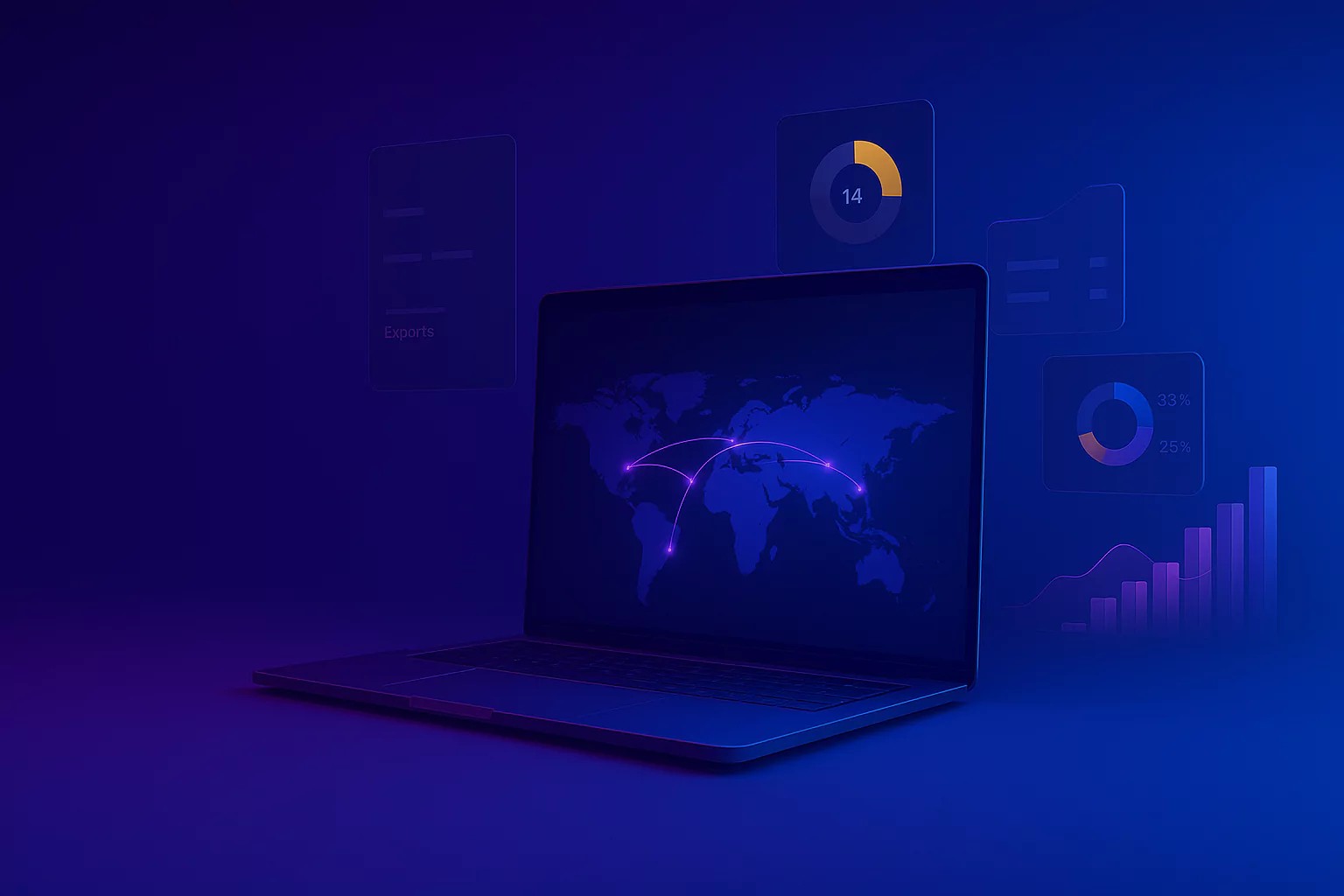Direct Distribution vs. Indirect Distribution: Evaluating Effectiveness in Market Penetration
Direct Distribution vs. Indirect Distribution: Evaluating Effectiveness in Market Penetration
Distribution channels are the network of companies, individuals, and intermediaries that enable the movement of a product or service from the manufacturer to the final consumer. The choice between direct distribution, where a company sells directly to consumers, and indirect distribution, which relies on intermediaries, can significantly influence market penetration. This refers to the extent to which a product or service is recognized and bought by customers in a specific market.
Selecting the most appropriate distribution channel allows businesses to reach their target audience, build brand awareness, and gain a competitive advantage. This comprehensive guide explores the advantages and disadvantages of direct and indirect distribution, providing insights that guide companies into making the right decision and maximizing their market penetration.
Direct Distribution
In a direct distribution model, businesses assume responsibility for delivering their products or services directly to consumers through various means, such as online platforms and retail stores. This not only enables them to establish direct links with their customers but also ensures more effective communication.
Advantages of Direct Distribution
Direct distribution offers several advantages for businesses, particularly in areas such as process control, customer relationships, time-to-market, and finances. These benefits include:
- Higher control over the consumer process: With direct distribution, businesses have complete oversight of how their products or services are presented, sold, and delivered to customers. This level of control allows them to ensure a consistent consumer experience and uphold high quality standards throughout the customer journey.
- Deeper and long-term customer relationships: Direct distribution enables companies to interact directly with their customers, fostering deeper, more personalized connections. This direct engagement allows companies to better understand their customers’ needs, preferences, and pain points, leading to enhanced offerings and customer loyalty.
- Faster product delivery: By eliminating intermediaries, direct distribution can streamline the supply chain and reduce the time it takes for products or services to reach customers. This efficiency is particularly important in situations where a product or service is needed urgently, such as emergency equipment.
- Reduced external fees: Direct distribution allows businesses to avoid paying fees or commissions to intermediaries, resulting in significant cost savings that can be passed on to customers or reinvested into the business.
- Retention of full profits from sales: With direct distribution, companies retain all the profits from their sales instead of sharing them with intermediaries. This often leads to higher profit margins and more resources for growth and innovation.
Disadvantages of Direct Distribution
Despite the numerous benefits, direct distribution also comes with certain drawbacks that companies must consider before opting for this approach. These are related to risks, financial investments, market coverage, and audits:
- Increased financial risk: In a direct distribution model, companies bear 100 percent of the financial risks associated with distribution processes, including inventory management, shipping, and potential product losses.
- Significant capital investment: Establishing a direct distribution network requires substantial investments in infrastructure, such as warehouses, logistics systems, trucks, and delivery personnel. These upfront costs can be a barrier for smaller businesses or those with limited financial resources.
- Limited market coverage: Direct distribution can restrict a company’s ability to reach a wide geographic area or diverse customer segments. Without the help of intermediaries who have established networks and local expertise, businesses may find it challenging to expand their market presence.
Impeccable documentation and tax records: Engaging in direct distribution increases the likelihood of audits due to the complexity of managing the entire process. Companies must maintain detailed documentation and tax records to ensure regulatory compliance and avoid penalties.
Indirect Distribution
Indirect distribution involves the use of intermediaries such as wholesalers and retailers to manage distribution processes on behalf of businesses. These intermediaries are responsible for storing, promoting, and selling goods to the end consumers. For more insights into the key actors involved in distribution channels, please refer to our article on the role of distribution channels in a route-to-market strategy.
Advantages of Indirect Distribution
Indirect distribution offers several advantages related to network access, start-up costs, and management. The following points outline the primary benefits of having an indirect distribution channel:
- Leverage expertise and networks: Businesses can tap into the expertise, networks, and reputation of intermediaries, enabling access to a broader customer base and new markets. This includes their knowledge of local market dynamics and how to best sell products or services in those areas.
- Reduced startup costs: Indirect distribution frees businesses from the financial burden of establishing their own distribution networks. Intermediaries often come equipped with existing infrastructure, such as warehouses and transportation systems, which manufacturers can utilize to minimize initial investments.
- Simplified management: Partnering with the right intermediaries can streamline the management of distribution channels, as they manage day-to-day operational tasks. This delegation allows businesses to concentrate on their core competencies, such as product development and innovation.
Disadvantages of Indirect Distribution
While indirect distribution offers several advantages, it also presents drawbacks related to product representation, delivery times, costs, profit sharing, and competition. The following are key factors to consider:
- Limited control over product representation: Companies may struggle to maintain full control over how distributors present their products or services. This lack of oversight can result in inconsistencies in messaging or customer experience, potentially harming the company’s reputation and market penetration efforts.
- Potential delays in delivery: Indirect distribution can extend delivery timelines, as products or services pass through intermediaries before reaching end consumers. This is particularly challenging for businesses dealing with time-sensitive or perishable goods, and can lead to decreased customer satisfaction and lost sales opportunities.
- Increased costs and reduced profitability: The addition of intermediaries in the distribution process can introduce extra costs, which may ultimately be passed on to consumers as higher prices.
- Shared profits with intermediaries: Companies must share their profits with the intermediaries involved in the distribution process, limiting their ability to reinvest in other business areas.
Competition within the distribution channel: Retailers may sell a company’s products or services alongside those of its competitors, leading to increased competition within the distribution channel. This environment can make it more challenging for a company to differentiate its offerings and capture market share.
How to Select the Right Channel for Your Business
Selecting the appropriate distribution channel is essential for optimizing your business’s reach and efficiency. This process involves a thorough analysis of your products or services, target market, and industry dynamics.
Key Factors to Consider
1. Product and Service Characteristics
The specific features and characteristics of your products or services is the main factor that should affect your choice of distribution channel. For instance, products that require specialized handling or storage, such as fragile items or temperature-sensitive goods, may be better suited for direct channels to ensure careful management throughout the delivery process. Another example is a consulting firm delivering financial advice directly through in-person meetings or virtual consultations to tailor its services to client needs and foster trust-based relationships.
2. Capital Investment
Evaluate the capital investment you are prepared to make, as each distribution channel entails specific costs that your business must either absorb or pass on to customers. For instance, a travel agency investing in its own booking platform will incur upfront costs, such as for website development and marketing, compared to one that relies on third-party platforms.
3. Delivery Speed
Evaluate how quickly you want your products delivered, analyze competitors’ delivery times, and ensure that your chosen channel can meet or exceed customer expectations to enhance their satisfaction and loyalty. For example, products with a shorter shelf life may benefit from direct distribution to minimize delays and maintain quality.
4. Control Over Customer Experience
Determine the level of control you wish to maintain over your products. For instance, companies like Amazon and Shopify enable manufacturers to sell directly to consumers, allowing them to retain full control over branding and customer interactions.
5. Geographic Location
Certain channels may be more effective in specific regions or for particular market segments. For example, a technology consulting firm specializing in cybersecurity might thrive with direct sales through regional offices near major corporate hubs.
6. Supporting Commodities
Consider the resources required to support your distribution efforts, such as technology infrastructure and personnel. For instance, a healthcare logistics company that uses indirect distribution methods may rely on third-party services for transportation and warehousing of medical supplies.
7. Market Conditions
Stay informed about market trends, including consumer preferences and competitive dynamics. Regularly monitoring these factors allows you to adapt your distribution strategy whenever necessary to remain competitive. For example, a financial advisory firm that relies on third-party brokers may struggle to adapt quickly to the growing demand for sustainable investment options.
Many businesses find success using a combination of direct and indirect channels, balancing control, cost, and market reach effectively. By carefully evaluating options and remaining flexible, you can develop a distribution strategy that not only supports but also drives growth and success for your business.
How Research Can Help
Research plays a key role in selecting the most suitable distribution channel for your business. By gathering and analyzing data, you can make informed decisions that align with your goals and maximize your potential. It helps you choose between direct and indirect distribution, select the right partner in indirect distribution, and evaluate and track your decision.
Choosing Between Direct and Indirect Distribution
When deciding between direct and indirect distribution channels, research can help you with the following:
- Market understanding: Uncover key insights about your target customers, competitive landscape, and local factors influencing business operations to determine which distribution approach is most likely to resonate with your audience and provide a competitive edge.
- Cost evaluation: Analyze the financial implications of both channels, estimating the setup costs, ongoing expenses, and potential returns on investment to ensure alignment with budgets and financial goals.
- Risk assessment: Evaluate the risks associated with each distribution model, highlighting potential challenges such as market saturation, regulatory concerns, and supply chain disruptions. Understanding these risks enables you to create contingency plans and allocate resources more effectively.
- Channel alignment: Ensure that your chosen channel aligns with your products or services, target market, and overall business objectives, taking into account factors like product or service complexity, customer preferences, and brand positioning.
Selecting the Right Partner in Indirect Distribution
Selecting the right distribution partners is crucial for achieving your business objectives. Research can help you evaluate potential partners against several important criteria:
- Market reach: Examine the market reach of potential partners by analyzing their distribution networks, customer base, and geographic coverage to ensure they can effectively promote and sell your products or services to your target audience. Partners with a strong market presence and established relationships can significantly enhance your brand visibility and sales potential.
- Capabilities: Evaluate the capabilities of prospective partners to determine if they possess the necessary expertise, resources, and infrastructure to support your distribution goals. Research their logistical capabilities, storage facilities, marketing strategies, and customer support services to ensure they can meet your expectations and deliver a high-quality customer experience.
- Cost-effectiveness: Analyze their pricing structures, commission rates, and any additional fees associated with their services. Consider the potential return on investment each partner offers and whether their costs align with your budget and financial objectives.
- Current partners: Explore the existing partnerships of potential distributors to gain insights into their business practices and reputation. Research the brands they are collaborating with, the duration of these partnerships, and any available feedback or testimonials. This information will help you assess their reliability and ability to maintain long-term client relationships.
- Track record: Examine the track record of potential partners by looking into their past performance, growth trajectory, and any notable successes or challenges they have encountered. A partner with a proven history of delivering results and adapting to market changes can offer valuable support and expertise to help your business thrive in the long run.
Evaluating Your Choice and Tracking Results
After selecting a distribution channel, ongoing evaluation and result tracking are essential for ensuring long-term success. Research can enhance this process in several key ways:
- Customization of strategy: Allows you to tailor your distribution strategy to the specific characteristics of each market. By gathering insights into local preferences and consumer behavior, you can refine your approach and minimize costly missteps.
- Market tracking and trend analysis: Helps you stay informed about market changes, anticipate emerging trends, and analyze the competitive landscape. Regularly monitoring market dynamics enables you to adapt your distribution strategies, seize new opportunities, and mitigate potential risks.
Infomineo: Distribution Channel Analysis for Enhanced Market Penetration
At Infomineo, we guide clients in navigating the complexities of local markets and distribution strategies to ensure optimal business performance. Through a comprehensive approach and a deep understanding of market dynamics, we benchmark local distributors to assess their capabilities, pricing strategies, and partners. By leveraging diverse resources, we ensure that our clients’ distribution channels align strategically with market realities and business objectives.
Our dedicated research team maintains continuous engagement to provide timely information on market trends and monitor competition. These insights empower our clients to adapt their strategies to shifting dynamics, ensuring business agility and competitiveness.
Frequently Asked Questions
What is the difference between direct and indirect distribution?
Direct distribution involves selling products directly to consumers without intermediaries, while indirect distribution relies on intermediaries such as wholesalers, retailers, or agents to distribute products to the end users.
What are the main advantages of direct distribution?
Direct distribution offers higher control over the consumer experience, enables building long-term customer relationships, and allows for faster product delivery. It also eliminates external fees and profit-sharing with intermediaries, potentially leading to higher profit margins for the company.
What are the key benefits of indirect distribution?
Indirect distribution allows companies to leverage the expertise, network, and reputation of intermediaries to access more customers and markets. It can reduce startup costs and simplify distribution management. However, it may limit control over product representation and increase costs.
How can a business choose the right distribution channel?
Selecting the right distribution channel involves considering factors like the type of products, capital investment, desired delivery speed, level of control, business location, required commodities, and market conditions. Regularly monitoring performance and gathering feedback helps in making necessary adjustments to the distribution strategy.
What role does research play in selecting a distribution partner?
Research helps in benchmarking potential distribution partners based on their market reach, capabilities, cost-effectiveness, current partnerships, and track record. This information allows businesses to make informed decisions when choosing a partner that aligns with their distribution goals and can support long-term success.
Wrapping It Up
Selecting the right distribution channel significantly influences a business’s success in penetrating the market. By carefully evaluating the advantages and disadvantages of both direct and indirect distribution, companies can make informed strategic decisions based on key factors such as product type, capital investment, delivery speed, control, location, necessary resources, and market conditions. Research is essential for understanding market dynamics, assessing costs and risks, and ensuring alignment with chosen channels. When opting for indirect distribution partners, businesses should thoroughly evaluate their market reach, capabilities, cost-effectiveness, existing partnerships, and track record. Consistent performance monitoring and adaptability based on feedback and emerging market trends also enable companies to refine their distribution strategies for sustained success. By making data-driven decisions and remaining agile, businesses can effectively penetrate markets and achieve sustainable growth through their selected distribution channels.










